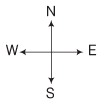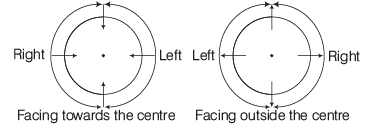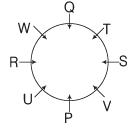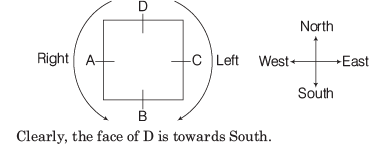Overview: Seating Arrangement (Linear and Circular) | CSAT Preparation - UPSC PDF Download
| Table of contents |

|
| CSAT Angle |

|
| Seating Arrangement |

|
| Pattern of Seating Arrangement |

|
| Circular Arrangement |

|
| Other Arrangements |

|
CSAT Angle
As per the analysis of Previous Years’ Papers, it has come to the notice that in the year two questions in 2023, one question in 2022 two questions and in other previous years almost every year one question has been asked from this chapter. Questions asked in exam are either about the position of some persons in the arrangement or the number of persons between two persons, etc.
Seating Arrangement
- Sitting arrangement questions are based on the sitting sequence pattern, direction, facing outside or inside etc. The candidates are required to understand all the conditions provided to them as the given information may be in jumbled or unjumbled pattern. The candidate has to segregate this information and make the sitting arrangement on the basis of given information.
- Sitting arrangement is the systematic process of placing some persons or/objects according to the given conditions and as per the requirement of the situation.
- The adequate and accurate pattern of allowing the persons as per the given rules to sit in a linear, circular or rectangular sequence is called sitting arrangement.

Pattern of Seating Arrangement
The sitting arrangement could be based on different pattern which have been discussed below:
Linear Arrangement
Under linear arrangement persons/objects either in standing or sitting position are supposed to be placed in proper order which could be a straight line.
One is required to identify the objects and their positions with respect to one another based on the information given about
(i) their exact position
(ii) their position with respect to another object
One need is to determine a unique arrangement of objects satisfying all the given conditions based on which the related questions can be answered.
There are two types of linear arrangements
1. Single linear arrangement: In this arrangement, some objects are given and we have to arrange them in a line using the given conditions. For it, use pictorial form and show each information step by step in it to come up with the relevant facts.
Directions: (Illustrations 1-3) Study the following information carefully and answer the questions given below.
Six friends A, B, C, D, E and F are sitting in a row facing towards North. C is sitting between A and E. E is not at the end. B is sitting immediate right of E. F is not at the right end. D is sitting second to the left end.
Illustration 1: How many persons are there to the right of D?
(a) One
(b) Two
(c) Three
(d) Four
Illustration 2: Which of the following is sitting to the left of D?
(a) F
(b) C
(c) E
(d) A
Illustration 3: Who is at the right end ?
(a) A
(b) B
(c) E
(d) Cannot be determined
Sol: (Illustrations 1-3) According to the given information, the correct arrangement of six friends as below: To arrange the friends, we will use every piece of information step-by-step.
To arrange the friends, we will use every piece of information step-by-step.
First of all, we have to arrange A, B, C, D, E and F.
As, C is sitting between A and E. Therefore, these three can be arranged as follow:
Now, given B is sitting immediate right of E, Fig. (ii) will follow and the arrangement of A, C, E and B will be as follow:

As, D is sitting second to the left end, therefore

And F is not at the right end, therefore, final arrangement becomes
Using this arrangement, we can answer the questions asked.
1. (d) There are four persons (A, C, E and B) to the right of D.
2. (a) From the final arrangement, it is clear that, F is sitting to the left of D.
3. (b) It is clear from the final arrangement that, B is at the right end.
2. Linear arrangement in two rows: In this arrangement, given objects have to be arranged in double rows parallel to each other. Usually, their directions are opposite to each other e.g. some may have North facing and some may have South facing. Like single linear arrangement use pictorial form to arrange them.
Directions (Illustrations 4-5): Read the following information carefully and then answer the question that follow:
I. Six flats on a floor in two rows, facing North and South are allotted to P, Q, R, S, T and U.
II. Q gets a North facing flat and is not next to S.
III. S and U get diagonally opposite flats.
IV. R next to U, gets a South facing flat and T gets a North facing flat.
Illustration 4: Whose flat is between Q and S?
(a) T
(b) U
(c) R
(d) Data inadequate
Illustration 5: The flats of which of the pair other than SU, is diagonally opposite to each other?
(a) PT
(b) QP
(c) QR
(d) TS
Sol: (Illustrations 4-5) According to the given information, arrangement of six flats is as follows:
4. (a) Clearly, T’s flat is between Q and S.
5. (b) As given in Statement III, S and U are diagonally opposite (at the ends). Similarly, from the figures, we can say P and Q are diagonally opposite.
Circular Arrangement
In this arrangement, some persons are sitting around a circle and their face may be towards the centre or outside the centre. As, in linear arrangement, we use pictorial representation to arrange given objects or persons in circular arrangement.
Directions (Illustrations 6-7): Read the following information carefully and answer the questions based on it.
P, Q, R, S, T, U, V and W are eight friends. They are sitting around a round table and taking coffee. Facing towards the centre.
I. P is sitting between U and V.
II. Q is sitting between W and T.
III. R is sitting to the third left of V.
IV. W is sitting to the third right of S.
Illustration 6. What is the position of V with respect to S ?
(a) Immediate left
(b) Immediate right
(c) Third to the left
(d) Fourth to the left
Illustration 7: What is the position of T with respect to W ?
(a) Immediate left
(b) Immediate right
(c) Third to the left
(d) Second to the left
Sol: (Illustrations 6-7) It is given that they are taking coffee, so it means that they are facing centre. So, the given figure shows the correct sitting arrangement of all eight friends sitting around the circle.
6. (a) It is clear, from the diagram, V is immediate left of S.
7. (d) Clearly, T is sitting second to the left of W.
Other Arrangements
In the exams, most of the problems are asked based on linear arrangement or on circular arrangement. But you may be asked to arrange the persons in rectangular arrangement or in pentagon arrangement etc.
Whatever arrangement i.e. but the process of solving problem based on the sitting is always same.
Illustration 10. Four persons A, B, C and D are playing cards. In this game, A makes a pair with C and B makes a pair with D. D is to the right of C whose face is towards West. Which direction D is facing?
(a) West
(b) East
(c) North
(d) South
Sol: (d)
|
205 videos|258 docs|136 tests
|
FAQs on Overview: Seating Arrangement (Linear and Circular) - CSAT Preparation - UPSC
| 1. What is the difference between linear and circular seating arrangements? |  |
| 2. How can one solve seating arrangement questions effectively in competitive exams? |  |
| 3. What are some common strategies to tackle circular seating arrangement questions? |  |
| 4. Are there any tips to improve speed and accuracy in solving seating arrangement questions? |  |
| 5. How important is practice in mastering seating arrangement questions for exams? |  |















